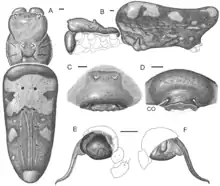Nephila komaci
Nephila komaci is a species of golden orb-web spider. It is the largest web-spinning spider known.[2] A few specimens have been found in South Africa and Madagascar.
| Nephila komaci | |
|---|---|
 | |
| Diagnostic drawings of female, and male + female reproductive organs | |
| Scientific classification | |
| Kingdom: | Animalia |
| Phylum: | Arthropoda |
| Subphylum: | Chelicerata |
| Class: | Arachnida |
| Order: | Araneae |
| Infraorder: | Araneomorphae |
| Family: | Araneidae |
| Genus: | Nephila |
| Species: | N. komaci |
| Binomial name | |
| Nephila komaci | |
Discovery
This species was first identified in a Pretoria museum collection in 2000. The species is named in honor of Andrej Komac, a late friend of one of the arachnologists who reported its discovery in 2009.[2] It was not discovered in the wild until 2007, when it was located in Tembe Elephant Park in South Africa.[3]
It was one of the first new Nephila spiders to be discovered in more than a century; most were discovered in the 19th century.[4]
Description
N. komaci females are the largest Nephila yet discovered. Displaying sexual size dimorphism commonly observed in various species of spiders, the size of a male reaches a leg span of only about 2.5 centimetres, with a body length of about 9 mm,[3] roughly one fifth of that of a female.[2] The tip-to-tip leg span of a female is about 12 cm (body length c. 4 cm),[3] with a web that is equally impressive in size, measuring more than a metre in diameter.
Reproduction
Males wait for a female to molt, and immediately afterwards inseminate her, breaking off their genitalia within the female, which thereby acts as a plug to prevent other males from mating with her. The now sterile male then spends the rest of his life (life span: about one year)[3] driving away other males. Nevertheless, females with several dismembered male organs within them have been found.[3]
Distribution
All known localities lie within two endangered biodiversity hotspots: Maputaland-Pondoland-Albany and Madagascar.[2] Its only definitive current habitat is a sand forest in Tembe Elephant Park, which is in itself endangered.
References
- "Taxon details Nephila komaci (Linnaeus, 1767)", World Spider Catalog, Natural History Museum Bern, retrieved 2017-05-15
- Kuntner, M.; Coddington, J.A. (2009), "Discovery of the Largest Orbweaving Spider Species: The Evolution of Gigantism in Nephila", PLOS ONE, 4 (10): e7516, doi:10.1371/journal.pone.0007516, PMC 2760137, PMID 19844575
- Dell'Amore, Christine (2009-10-21), "Largest Web-Spinning Spider Found", National Geographic News, National Geographic Society, retrieved 2009-10-24
- "Gen. Nephila Leach, 1815". World Spider Catalog. Natural History Museum Bern. Retrieved 2017-05-13.